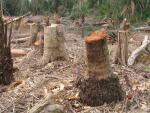Deforestation in Haiti: Weaning a Country off of Wood Fuels
 Attached is an assessment carried out by the World Bank's Energy Sector Management Assistance Program (EMAP) on Haiti's reliance on wood based charcoal for its energy needs - estimated to be about 70% of total energy usage. Having read the assessment, I feel it raises some sensible interventions even if they do not go far enough. However, the strategy could provide a foundation upon which to build.
Attached is an assessment carried out by the World Bank's Energy Sector Management Assistance Program (EMAP) on Haiti's reliance on wood based charcoal for its energy needs - estimated to be about 70% of total energy usage. Having read the assessment, I feel it raises some sensible interventions even if they do not go far enough. However, the strategy could provide a foundation upon which to build.
 Haiti's environmental damage is severe, and if it cannot be reversed, it will continue to negative effect the country's health, wealth, and stability. There are a wide variety of choices, but all will require strong coordination between the Haitian government and civil society, donors, and international organizations. If we can all agree on these points, we can skip ahead to the hard part. What should be done, by who, and how? Let's start with what EMAP proposes. The five components of the strategy they are advocating for are below:
Haiti's environmental damage is severe, and if it cannot be reversed, it will continue to negative effect the country's health, wealth, and stability. There are a wide variety of choices, but all will require strong coordination between the Haitian government and civil society, donors, and international organizations. If we can all agree on these points, we can skip ahead to the hard part. What should be done, by who, and how? Let's start with what EMAP proposes. The five components of the strategy they are advocating for are below:
Set up an institutional mechanism to coordinate this strategy. The overarching goals of the mechanism should focus on improved land management by farmers, more efficient use of woodfuels, producing more efficient stoves, importing substitution fuels, and importing or manufacturing equipment needed for producing substitution fuels. This mechanism must include members of the Haitian government and (gasp) the Diaspora, international organizations, donors, and civil society. We throw the word around a lot, who do we mean when we talk about civil society? That includes religious groups, the Red Cross, the Rotary Clubs, community organizations large and small, and even political parties. Reforesting the country should be something that, regardless of political beliefs, we all can agree is needed.
Reducing wood fuel demand by promoting more efficient stoves: This component focuses on making available more efficient "Mirak" style stoves to 80% of Port au Prince households, training artisans to produce them. This component does not address the root causes of wood fuel usage, but it does curb the damage to a certain extent.
Promote alternative fuel imports: This would include Liquified Petroleum Gas, Kerosene, and Coal. The Dominican Republic may be a model here in that they have long subsidized propane. Granted, Haitians have less purchasing power than Dominicans so the subsidies would have to be higher, but it could be part of a solution. We recommend pilot programs that could be scaled up with donor support once proven effective.
Foster local options to substitute charcoal and firewood: This would include using agricultural waste to produce briquettes. I've seen this done successfully in small communities but never really brought up to scale. Converting waste to fuel makes good economic and environmental sense. We've found that people are reluctant to adopt new innovations such as this until the opinion leaders in the community have - if working on such a project, get the buy in of local leaders first.
Boosting supply: This component focuses on integrating firewood into rural development programs and developing ways to make it sustainable through improved forestry management.
 The cost of the strategy is estimated to be about 20 million dollars over the course of five years, half of which could be provided by the private sector. It is estimated charcoal production would decrease by 20% over ten years. Sadly, the report notes that consumption is likely to increase again in 11 or 12 years as a result of demographic growth. This suggests the need for action beyond what this strategy is proposing.
The cost of the strategy is estimated to be about 20 million dollars over the course of five years, half of which could be provided by the private sector. It is estimated charcoal production would decrease by 20% over ten years. Sadly, the report notes that consumption is likely to increase again in 11 or 12 years as a result of demographic growth. This suggests the need for action beyond what this strategy is proposing.
Don't get me wrong. All of the proposed interventions are interesting and would makea dent in charcoal consumption. But at this late stage, making a dent does not suffice. Perhaps more so than any other country in the Western Hemisphere, Haiti needs innovative approaches. We agree with the interventions proposed but disagree with the lack of a sense of urgency and willigness to think outside the box.
 Environmental rehabilitation must be linked to livelihoods. We propose the immediate funding of an environmentally oriented Civilian Conservation Corps, to be piloted in each Department through a public/private partnership and then scaled up accordingly. Part of the Corps must be consist of rangers who patrol and protect the few remaining forested areas. As charcoal becomes more rare, it is worth more. Sadly, trying to prevent people from cutting down trees may put a person at risk - as conversationists try to protect the environment, they must be protected themselves.
Environmental rehabilitation must be linked to livelihoods. We propose the immediate funding of an environmentally oriented Civilian Conservation Corps, to be piloted in each Department through a public/private partnership and then scaled up accordingly. Part of the Corps must be consist of rangers who patrol and protect the few remaining forested areas. As charcoal becomes more rare, it is worth more. Sadly, trying to prevent people from cutting down trees may put a person at risk - as conversationists try to protect the environment, they must be protected themselves.
 In order to help Haiti become energy secure, an array of interventions are needed. For now, subsidizing propane would be a big help. We propose the rapid expansion of solar and wind power, solar for facilities and wind in rural areas. The initial investment may be expensive, but the sun and wind are free. A further advantage of wind power, is that it would be exceedingly difficult and counter-productive to steal a windmill. Solar panels, if not bolted down very well, have a tendency to go missing. Thieves took the panels off of our Teleco in Thomonde and they had to be replaced. In the meantime, no phone calls.
In order to help Haiti become energy secure, an array of interventions are needed. For now, subsidizing propane would be a big help. We propose the rapid expansion of solar and wind power, solar for facilities and wind in rural areas. The initial investment may be expensive, but the sun and wind are free. A further advantage of wind power, is that it would be exceedingly difficult and counter-productive to steal a windmill. Solar panels, if not bolted down very well, have a tendency to go missing. Thieves took the panels off of our Teleco in Thomonde and they had to be replaced. In the meantime, no phone calls.
 Alternate energy sources can't be brought to scale overrnight. Until then, electification of Haiti and especially its urban areas is key. Buying electricity from the Dominican Republic is an imperfect, but practical, solution in the meantime. Haiti is not an ideal country for hydroenergy. The Pelligre Dam can be modernized somewhat, but this will only go so far.
Alternate energy sources can't be brought to scale overrnight. Until then, electification of Haiti and especially its urban areas is key. Buying electricity from the Dominican Republic is an imperfect, but practical, solution in the meantime. Haiti is not an ideal country for hydroenergy. The Pelligre Dam can be modernized somewhat, but this will only go so far.
 Haiti could be the first country in the Western Hemisphere to really commit to biofuels. We would not be the first in the world - we could learn from what has been accomplished in the Phillipines and India. Study tours and exchanges of staff from the relevant ministries should not be hard to arrange. Being the first in the Western Hemisphere to systematically and seriously cultivate and process Jatropha would be a real accomplishment.
Haiti could be the first country in the Western Hemisphere to really commit to biofuels. We would not be the first in the world - we could learn from what has been accomplished in the Phillipines and India. Study tours and exchanges of staff from the relevant ministries should not be hard to arrange. Being the first in the Western Hemisphere to systematically and seriously cultivate and process Jatropha would be a real accomplishment.
 There are any number of interventions, each of which has risks and benefits. The hard part is developing a right balance between what will help a little bit now and what could help a great deal in the long term. As a recent article in the International Herald Tribune notes, Haiti's future will be grim indeed if deforestation is not addresses. Ethiopia and Uganda have begun to do so - we can too.
There are any number of interventions, each of which has risks and benefits. The hard part is developing a right balance between what will help a little bit now and what could help a great deal in the long term. As a recent article in the International Herald Tribune notes, Haiti's future will be grim indeed if deforestation is not addresses. Ethiopia and Uganda have begun to do so - we can too.
The assessment is attached below. If you were a consultant on the EMAP team, would you have suggested a similar strategy or something vastly different? We would be interested in hearing your thoughts and ideas.
Bryan
Add new comment